Preparation a High-Performance of Gangue-Based Geopolymer Backfill Material: Recipes Optimization Using the Taguchi Method
Abstract
1. Introduction
2. Materials and Methods
2.1. Materials
2.1.1. Aluminosilicate Materials
2.1.2. Gangue Aggregate Characteristics
2.1.3. Activator
2.2. Experimental Scheme
2.2.1. Research and Development Concepts for GBGBM
2.2.2. Design of Experiments by the Taguchi Method
- (i)
- Smaller the better: the goal of optimization is to minimize the reaction (e.g., reduce water secretion rate);
- (ii)
- Larger the better: the objective is to maximize the response (e.g., maximize the UCS);
- (iii)
- Nominal is best: the goal is to reach a target value, such as the slump target value.
2.2.3. Specimen Preparation and Testing
3. Results and Discussion
3.1. Range Analysis
3.1.1. Range Analysis of Slump S/N of GBGBM
3.1.2. Range Analysis of UCS’s S/N Ratio of GBGBM
3.2. Variance Analysis
3.3. Optimal Combination
3.4. Analysis of Microscopic Results
3.4.1. XRD Analysis
3.4.2. Pore Structure Analysis of GBCBM and GBGBM
3.4.3. SEM Analysis
3.5. Environmental Benefits
4. Conclusions
- (1)
- Taguchi’s approach yielded the following ideal ratios as the best combination: a gradation of 50%, a sand ratio of 55%, a w/b ratio of 0.64, and an a/b ratio of 2.5. As a consequence, the GBGBM’s slump was 251.2 mm, and the UCS at 3d and 28d was 5.27 MPa and 17.65 MPa, respectively. These findings indicate a remarkable improvement in early UCS by 131.14% and the late UCS by 49.45% compared to the GBCBM.
- (2)
- The results of the contributions analysis all showed that the w/b and a/b ratios were the factors that most significantly affect the slump and the UCS of the GBGBM.
- (3)
- The reason for the higher UCS of the GBGBM compared to the GBCBM can be attributed to the formation of more C-(A)-S-H and N-A-S-H gels. This is further supported by the lower porosity and denser structure observed in the GBGBM compared to the GBCBM.
- (4)
- The production of the GBGBM has demonstrated a significant reduction in CO2 emissions, energy consumption, and costs when compared to the conventional GBCBM.
Author Contributions
Funding
Institutional Review Board Statement
Informed Consent Statement
Data Availability Statement
Conflicts of Interest
References
- Kong, X.S.; Fang, J.; Liu, S.; Wang, S.; Xu, Z.Z. Study on the strength of the artificial dam of underground reservoir in Wulanmulun mine. IOP Conf. Ser. Earth Environ. Sci. 2019, 3, 032012. [Google Scholar] [CrossRef]
- Fan, L.; Ma, X. A review on investigation of water-preserved coal mining in western China. Int. J. Coal Sci. Technol. 2018, 5, 411–416. [Google Scholar] [CrossRef]
- Yao, Q.L.; Tang, C.J.; Xia, Z.; Liu, X.L.; Zhu, L.; Chong, Z.H.; Hui, X.D. Mechanisms of failure in coal samples from underground water reservoir. Eng. Geol. 2020, 267, 105494. [Google Scholar] [CrossRef]
- Behera, S.K.; Mishra, D.P.; Singh, P.; Mishra, K.; Mandal, S.K.; Ghosh, C.N.; Kumar, R.; Mandal, P.K. Utilization of mill tailings, fly ash and slag as mine paste backfill material: Review and future perspective. Constr. Build. Mater. 2021, 309, 125120. [Google Scholar] [CrossRef]
- Behera, S.K.; Ghosh, C.N.; Mishra, K.; Mishra, D.P.; Singh, P.; Mandal, P.K.; Buragohain, J.; Sethi, M.K. Utilisation of lead-zinc mill tailings and slag as paste backfill materials. Environ. Earth Sci. 2020, 79, 1–18. [Google Scholar] [CrossRef]
- Ercikdi, B.; Cihangir, F.; Kesimal, A.; Deveci, H.; Alp, I. Utilization of industrial waste products as pozzolanic material in cemented paste backfill of high sulphide mill tailings. J. Hazard. Mater. 2009, 168, 848–856. [Google Scholar] [CrossRef] [PubMed]
- Behera, S.K.; Ghosh, C.N.; Mishra, D.P.; Singh, P.; Mishra, K.; Buragohain, J.; Mandal, P.K. Strength development and microstructural investigation of lead-zinc mill tailings based paste backfill with fly ash as alternative binder. Cem. Concr. Compos. 2020, 109, 103553. [Google Scholar] [CrossRef]
- Mangane, M.B.C.; Argane, R.; Trauchessec, R.; Lecomte, A.; Benzaazoua, M. Influence of superplasticizers on mechanical properties and workability of cemented paste backfill. Min. Eng. 2018, 116, 3–14. [Google Scholar] [CrossRef]
- Du, X.J.; Feng, G.R.; Qi, T.Y.; Guo, Y.X.; Zhang, Y.J.; Wang, Z.H. Failure characteristics of large unconfined cemented gangue backfill structure in partial backfill mining. Constr. Build. Mater. 2019, 194, 257–265. [Google Scholar] [CrossRef]
- Turner, L.K.; Collins, F.G. Carbon dioxide equivalent (CO2-e) emissions: A comparison between geopolymer and OPC cement concrete. Constr. Build. Mater. 2013, 43, 125–130. [Google Scholar] [CrossRef]
- Zhang, J.; Shi, C.J.; Zhang, Z.H. Effect of Na2O concentration and water/binder ratio on carbonation of alkali-activated slag/fly ash cements. Constr. Build. Mater. 2021, 269, 121258. [Google Scholar] [CrossRef]
- Sun, B.B.; Ye, G.; de Schutter, G. A review: Reaction mechanism and strength of slag and fly ash-based alkali-activated materials. Constr. Build. Mater. 2022, 326, 126843. [Google Scholar] [CrossRef]
- Sun, Q.; Tian, S.; Sun, Q.W.; Li, B.; Cai, C.; Xia, Y.J.; Wei, X.; Mu, Q.W. Preparation and microstructure of fly ash geopolymer paste backfill material. J. Clean. Prod. 2019, 225, 376–390. [Google Scholar] [CrossRef]
- Izadifar, M.; Valencia, N.C.; Xiao, P.; Ukrainczyk, N.; Koenders, E. 3D Off-Lattice Coarse-Grained Monte Carlo Simulations for Nucleation of Alkaline Aluminosilicate Gels. Materials 2023, 16, 1863. [Google Scholar] [CrossRef] [PubMed]
- Izadifar, M.; Ukrainczyk, N.; Koenders, E. Silicate Dissolution Mechanism from Metakaolinite Using Density Functional Theory. Nanomaterials 2023, 13, 1196. [Google Scholar] [CrossRef] [PubMed]
- Zhu, H.; Yang, S.; Li, W.; Li, Z.; Fan, J.; Shen, Z. Study of Mechanical Properties and Durability of Alkali-Activated Coal Gangue-Slag Concrete. Materials 2020, 13, 5576. [Google Scholar] [CrossRef] [PubMed]
- Zhang, J.; Shi, C.J.; Zhang, Z.H.; Ou, Z.H. Durability of alkali-activated materials in aggressive environments: A review on recent studies. Constr. Build. Mater. 2017, 152, 598–613. [Google Scholar] [CrossRef]
- Jiang, H.Q.; Fall, M.; Yilmaz, E.; Li, Y.H.; Yang, L. Effect of mineral admixtures on flow properties of fresh cemented paste backfill: Assessment of time dependency and thixotropy. Powder Technol. 2020, 372, 258–266. [Google Scholar] [CrossRef]
- Sun, X.G.; Liu, J.; Qiu, J.P.; Wu, P.Q.; Zhao, Y.Q. Alkali activation of blast furnace slag using a carbonate-calcium carbide residue alkaline mixture to prepare cemented paste backfill. Constr. Build. Mater. 2022, 320, 956–965. [Google Scholar] [CrossRef]
- Jiang, H.Q.; Qi, Z.J.; Yilmaz, E.; Han, J.; Qiu, J.P.; Dong, C.L. Effectiveness of alkali-activated slag as alternative binder on workability and early age compressive strength of cemented paste backfills. Constr. Build. Mater. 2019, 218, 689–700. [Google Scholar] [CrossRef]
- Cavusoglu, I.; Yilmaz, E.; Yilmaz, A.O. Sodium silicate effect on setting properties, strength behavior and microstructure of cemented coal fly ash backfill. Powder Technol. 2021, 384, 17–28. [Google Scholar] [CrossRef]
- Sun, Q.; Li, T.; Liang, B. Preparation of a New Type of Cemented Paste Backfill with an Alkali-Activated Silica Fume and Slag Composite Binder. Materials 2020, 13, 372. [Google Scholar] [CrossRef]
- Yu, Y. Development for the New Backfilling Cementing Materials and Research on Its Properties in Coal Mine; China University of Mining and Technology: Beijing, China, 2017. [Google Scholar]
- Riahi, S.; Nazari, A.; Zaarei, D.; Khalaj, G.; Bohlooli, H.; Kaykha, M.M. Compressive strength of ash-based geopolymers at early ages designed by Taguchi method. Mater. Des. 2012, 37, 443–449. [Google Scholar] [CrossRef]
- Hadi, M.N.S.; Farhan, N.A.; Sheikh, M.N. Design of geopolymer concrete with GGBFS at ambient curing condition using Taguchi method. Constr. Build. Mater. 2017, 140, 424–431. [Google Scholar] [CrossRef]
- Qi, C.C.; Chen, Q.S.; Dong, X.J.; Zhang, Q.L.; Yaseen, Z.M. Pressure drops of fresh cemented paste backfills through coupled test loop experiments and machine learning techniques. Powder Technol. 2020, 361, 748–758. [Google Scholar] [CrossRef]
- Li, Y.L.; Lu, B.; Yang, R.S.; Lin, H.; Xu, B.; Wang, S.S.; Liu, C.H. Cemented backfilling mining technology with continuous mining and continuous backfilling method for underground coal mine and typical engineering cases. J. China Coal Soc. 2022, 47, 1055–1071. [Google Scholar] [CrossRef]
- Ren, A.; Feng, G.R.; Guo, Y.X. Influence on performance of coal mine filling paste with fly ash. J. China Coal Soc. 2014, 39, 2374–2380. [Google Scholar] [CrossRef]
- Sun, Q.; Zhang, X.D.; Zhang, S.K. Experimental Study on the Preparation of High-strength Paste Filling Materials with Mine’s Solid Waste. Non-Met. Mines 2015, 38, 42–44. [Google Scholar]
- Gu, Q.H. Mixing Proportion of Paste-like Filling Material based on Back-propagation Neural Network. Met. Mine 2016, 3, 40–43. [Google Scholar]
- GBT18046-2008; The Chinese National Standard—Ground Granulated Blast Furnace Slag Used for Cement and Concrete. China Standard Press: Beijing, China, 2008.
- Fan, J.C.; Zhang, B. Repair of ordinary Portland cement concrete using alkali activated slag/fly ash: Freeze-thaw resistance and pore size evolution of adhesive interface. Constr. Build. Mater. 2021, 300, 124334. [Google Scholar] [CrossRef]
- Chaulia, P.K.; Das, R. Process Parameter Optimization for Fly Ash Brick by Taguchi Method. Mater. Res.-Ibero-Am. J. Mater. 2008, 11, 159–164. [Google Scholar] [CrossRef]
- Zhou, N.; Zhang, J.; Ouyang, S.; Deng, X.; Dong, C.; Du, E. Feasibility study and performance optimization of sand-based cemented paste backfill materials. J. Clean. Prod. 2020, 259, 120798. [Google Scholar] [CrossRef]
- Jiang, B.; Xia, W.; Wu, T.; Liang, J. The optimum proportion of hygroscopic properties of modified soil composites based on orthogonal test method. J. Clean. Prod. 2021, 278, 123828. [Google Scholar] [CrossRef]
- Dueramae, S.; Tangchirapat, W.; Sukontasukkul, P.; Chindaprasirt, P.; Jaturapitakkul, C. Investigation of compressive strength and microstructures of activated cement free binder from fly ash—Calcium carbide residue mixture. J. Mater. Res. Technol. 2019, 8, 4757–4765. [Google Scholar] [CrossRef]
- Cong, P.; Mei, L. Using silica fume for improvement of fly ash/slag based geopolymer activated with calcium carbide residue and gypsum. Constr. Build. Mater. 2021, 275, 122171. [Google Scholar] [CrossRef]
- Suttiprapa, P.; Tangchirapat, W.; Jaturapitakkul, C.; Rattanasak, U.; Jitsangiam, P. Strength behavior and autogenous shrinkage of alkali-activated mortar made from low-calcium fly ash and calcium carbide residue mixture. Constr. Build. Mater. 2021, 312, 125438. [Google Scholar] [CrossRef]
- Zhao, X.; Liu, C.; Zuo, L.; Wang, L.; Zhu, Q.; Wang, M. Investigation into the effect of calcium on the existence form of geopolymerized gel product of fly ash based geopolymers. Cem. Concr. Compos. 2019, 103, 279–292. [Google Scholar] [CrossRef]
- Ma, Y.; Hu, J.; Ye, G. The pore structure and permeability of alkali activated fly ash. Fuel 2013, 104, 771–780. [Google Scholar] [CrossRef]
- Fan, J.; Zhu, H.; Shi, J.; Li, Z.; Yang, S. Influence of slag content on the bond strength, chloride penetration resistance, and interface phase evolution of concrete repaired with alkali activated slag/fly ash. Constr. Build. Mater. 2020, 263, 120639. [Google Scholar] [CrossRef]
- Nguyen, L.; Moseson, A.J.; Farnam, Y.; Spatari, S. Effects of composition and transportation logistics on environmental, energy and cost metrics for the production of alternative cementitious binders. J. Clean. Prod. 2018, 185, 628–645. [Google Scholar] [CrossRef]
- Phetchuay, C.; Horpibulsuk, S.; Arulrajah, A.; Suksiripattanapong, C.; Udomchai, A. Strength development in soft marine clay stabilized by fly ash and calcium carbide residue based geopolymer. Appl. Clay Sci. 2016, 127, 134–142. [Google Scholar] [CrossRef]
- Moseson, A.J.; Moseson, D.E.; Barsoum, M.W. High volume limestone alkali-activated cement developed by design of experiment. Cem. Concr. Compos. 2012, 34, 328–336. [Google Scholar] [CrossRef]
- Collins, F. Inclusion of carbonation during the life cycle of built and recycled concrete: Influence on their carbon footprint. Int. J. Life Cycle Assess. 2010, 15, 549–556. [Google Scholar] [CrossRef]
- Gao, X.; Yao, X.; Yang, T.; Zhou, S.M.; Wei, H.G.; Zhang, Z.H. Calcium carbide residue as auxiliary activator for one-part sodium carbonate-activated slag cements: Compressive strength, phase assemblage and environmental benefits. Constr. Build. Mater. 2021, 308, 125015. [Google Scholar] [CrossRef]
- Phoo-ngernkham, T.; Phiangphimai, C.; Intarabut, D.; Hanjitsuwan, S.; Damrongwiriyanupap, N.; Li, L.Y.; Chindaprasirt, P. Low cost and sustainable repair material made from alkali-activated high-calcium fly ash with calcium carbide residue. Constr. Build. Mater. 2020, 247, 118543. [Google Scholar] [CrossRef]
- Gong, X.Z.; Zhang, T.; Zhang, J.Q.; Wang, Z.; Liu, J.H.; Cao, J.W.; Wang, C.A. Recycling and utilization of calcium carbide slag-current status and new opportunities. Renew. Sustain. Energy Rev. 2022, 159, 112133. [Google Scholar] [CrossRef]
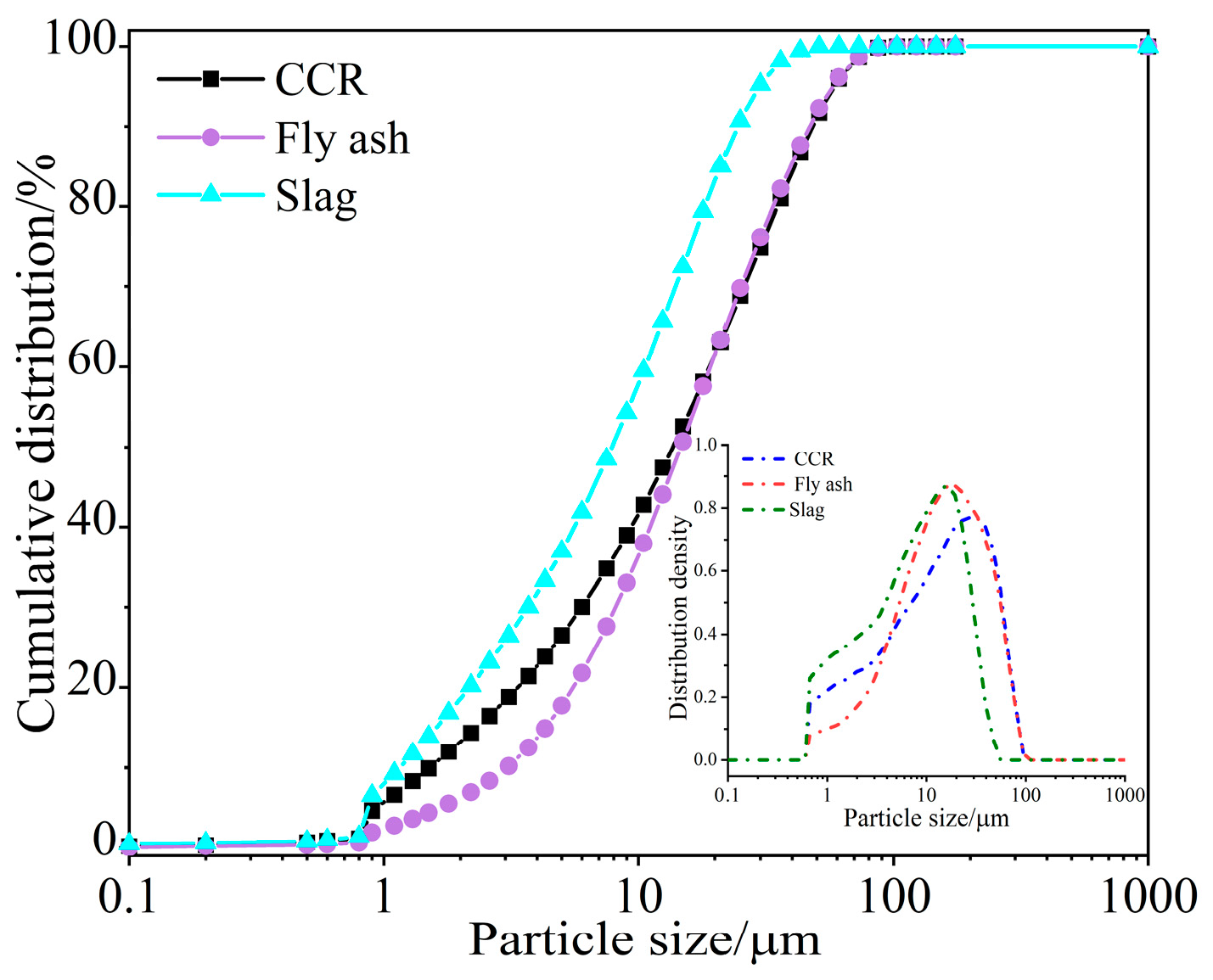






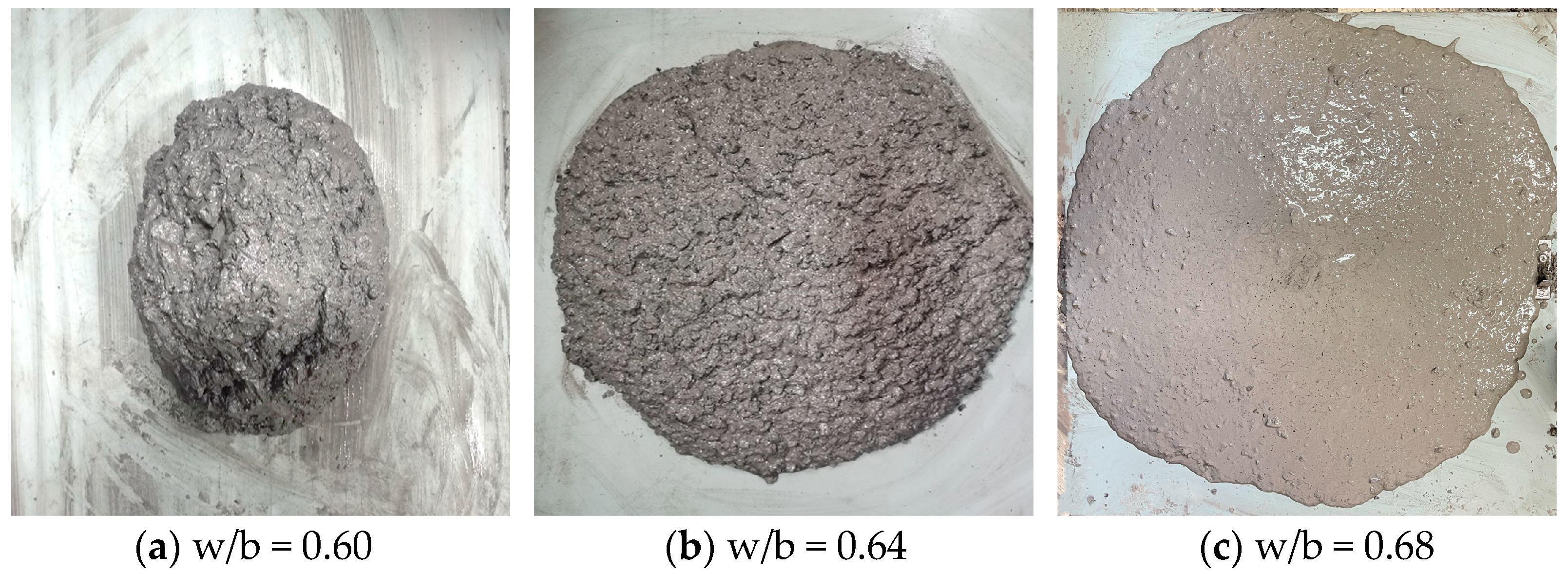

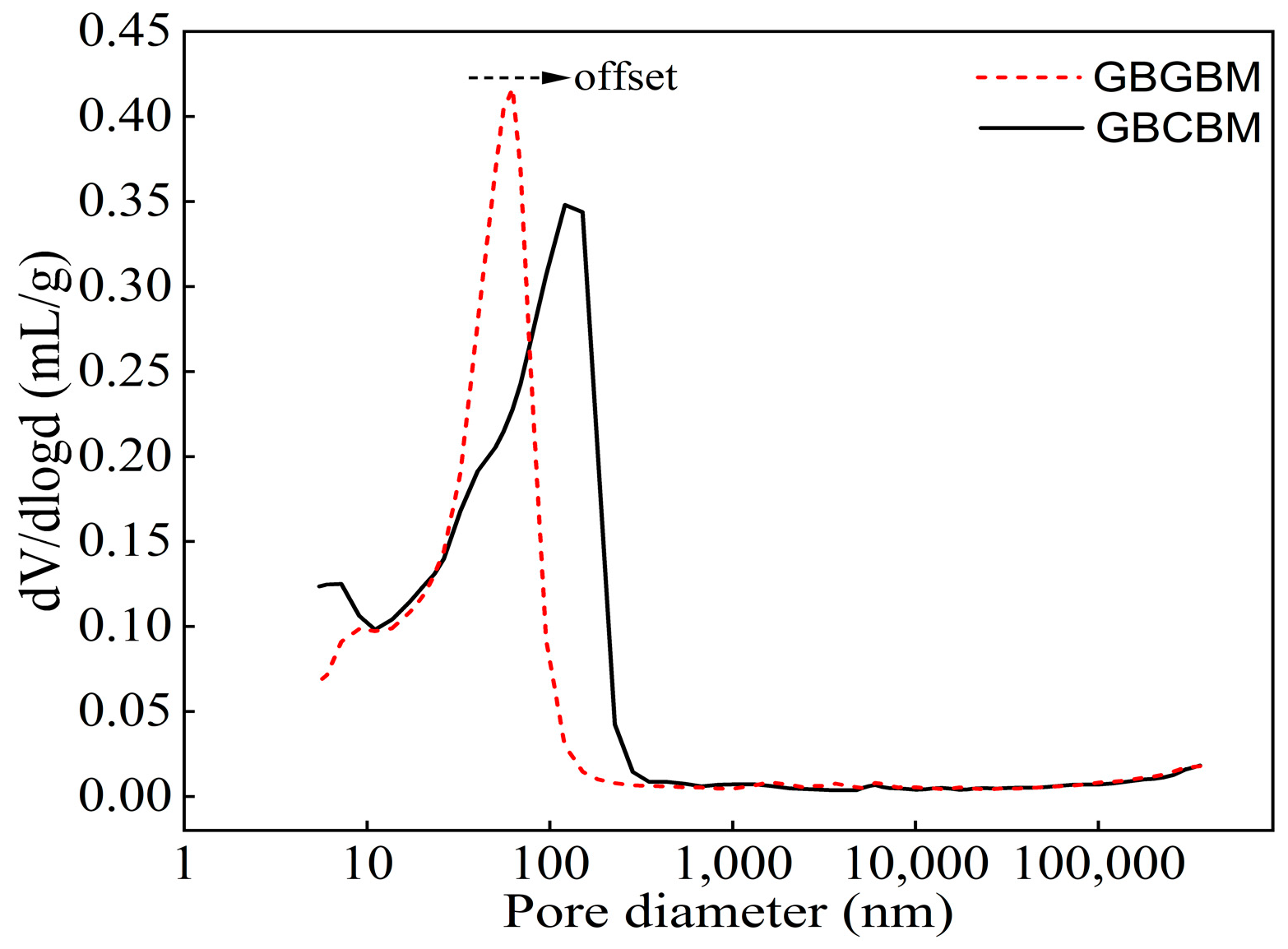
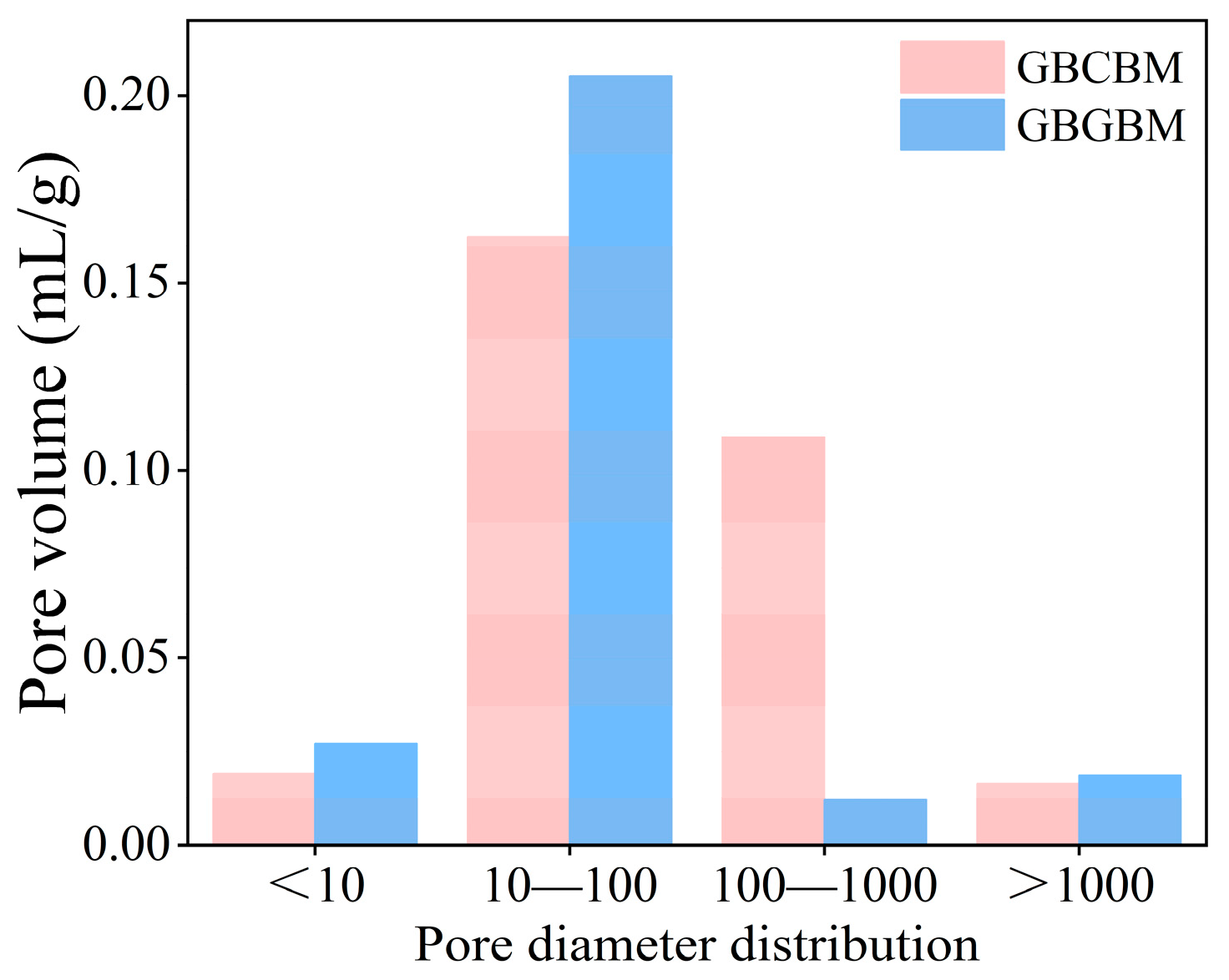
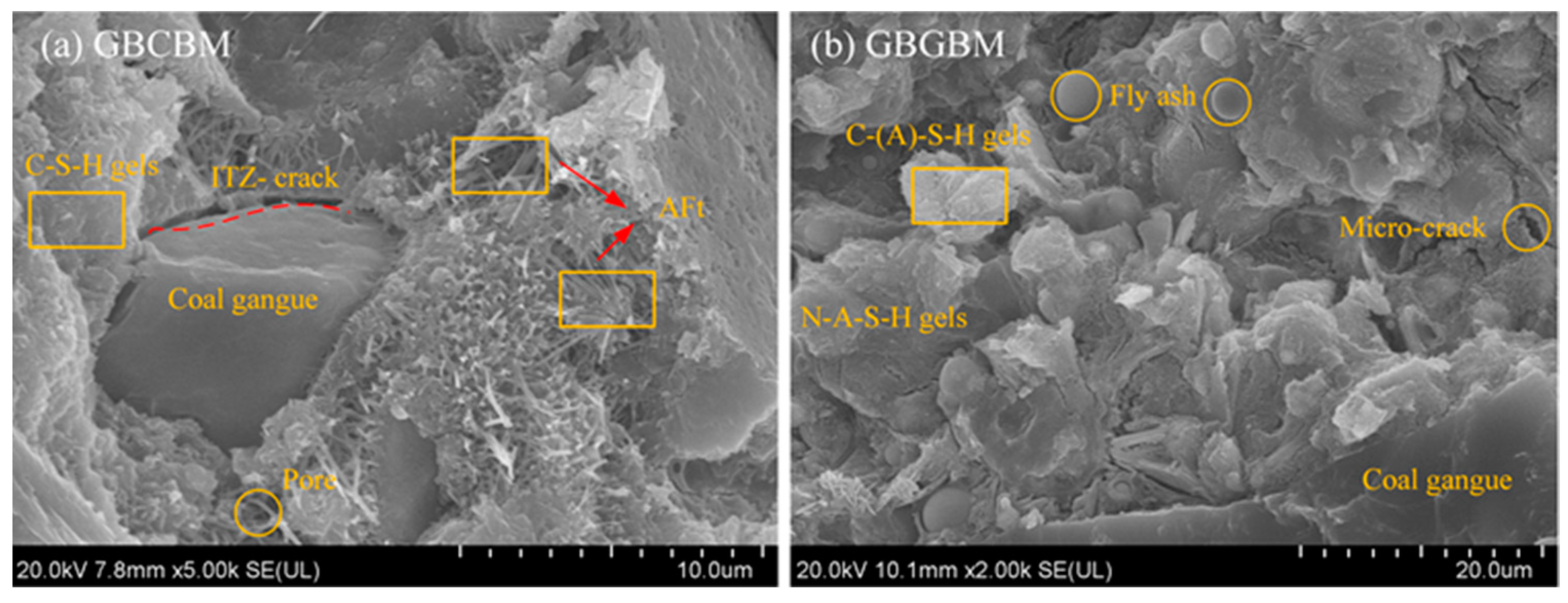
| Materials | CaO | SiO2 | Al2O3 | Fe2O3 | MgO | SO3 | K2O | TiO2 | LOI |
|---|---|---|---|---|---|---|---|---|---|
| Fly ash | 2.66 | 55.71 | 32.79 | 4.43 | 0.24 | 0.65 | 1.54 | 1.66 | 1.51 |
| Slag | 42.73 | 32.93 | 14.47 | 0.24 | 6.59 | 0.99 | 0.48 | 0.64 | 1.17 |
| CCR | 68.97 | 1.57 | 1.98 | 0.47 | - | 0.32 | - | - | 25.89 |
| OPC | 65.52 | 19.38 | 4.66 | - | 1.68 | 2.03 | - | - | 1.08 |
| Gangue | 0.15 | 70.20 | 17.63 | 1.50 | 0.29 | - | 0.88 | 0.45 | 8.51 |
| Types | Apparent Density kg/m3 | Water Content /% | Water Absorption /% | Crushing Index Value /% |
|---|---|---|---|---|
| Gangue | 2600 | 0.89 | 4.08 | 13.2 |
| Factors | Level 1 | Level 2 | Level 3 | Level 4 | Level 5 |
|---|---|---|---|---|---|
| gradtion | 100 | 75 | 50 | 25 | 0 |
| sand ratio | 40 | 45 | 50 | 55 | 60 |
| w/b | 0.6 | 0.62 | 0.64 | 0.66 | 0.68 |
| a/b | 2 | 2.25 | 2.5 | 2.75 | 3 |
| Specimes | Gradation | Sand Ratio | w/b | a/b | 3d/MPa | 28d/MPa | Slump/mm | S/N a | S/N b | S/N c |
|---|---|---|---|---|---|---|---|---|---|---|
| GBGBM-1 | 100 | 40 | 0.6 | 2 | 7.32 | 14.26 | 244.0 | 32.70 | 17.29 | 23.08 |
| GBGBM-2 | 100 | 45 | 0.62 | 2.25 | 6.25 | 13.74 | 238.5 | 33.66 | 15.92 | 22.76 |
| GBGBM-3 | 100 | 50 | 0.64 | 2.5 | 5.98 | 14.38 | 246.0 | 35.27 | 15.53 | 23.16 |
| GBGBM-4 | 100 | 55 | 0.66 | 2.75 | 5.31 | 14.18 | 236.5 | 40.94 | 14.50 | 23.03 |
| GBGBM-5 | 100 | 60 | 0.68 | 3 | 4.62 | 10.83 | 218.1 | 38.19 | 13.28 | 20.69 |
| GBGBM-6 | 75 | 40 | 0.62 | 2.5 | 5.77 | 15.14 | 236.0 | 28.88 | 15.22 | 23.60 |
| GBGBM-7 | 75 | 45 | 0.64 | 2.75 | 5.31 | 14.29 | 237.0 | 34.94 | 14.51 | 23.10 |
| GBGBM-8 | 75 | 50 | 0.66 | 3 | 4.41 | 12.71 | 232.8 | 39.47 | 12.86 | 22.08 |
| GBGBM-9 | 75 | 55 | 0.68 | 2 | 5.18 | 12.54 | 270.5 | 51.65 | 14.28 | 21.97 |
| GBGBM-10 | 75 | 60 | 0.6 | 2.25 | 6.27 | 16.18 | 226.5 | 40.57 | 15.94 | 24.17 |
| GBGBM-11 | 50 | 40 | 0.64 | 3 | 4.63 | 13.28 | 208.0 | 25.29 | 13.29 | 22.45 |
| GBGBM-12 | 50 | 45 | 0.66 | 2 | 5.22 | 14.02 | 284.0 | 46.06 | 14.36 | 22.93 |
| GBGBM-13 | 50 | 50 | 0.68 | 2.25 | 4.79 | 13.29 | 261.5 | 51.36 | 13.61 | 22.47 |
| GBGBM-14 | 50 | 55 | 0.6 | 2.5 | 6.39 | 18.92 | 221.4 | 40.97 | 16.11 | 25.54 |
| GBGBM-15 | 50 | 60 | 0.62 | 2.75 | 5.29 | 15.97 | 218.6 | 40.86 | 14.46 | 24.06 |
| GBGBM-16 | 25 | 40 | 0.66 | 2.25 | 4.64 | 13.42 | 262.5 | 37.41 | 13.33 | 22.55 |
| GBGBM-17 | 25 | 45 | 0.68 | 2.5 | 4.48 | 12.12 | 281.3 | 48.47 | 13.02 | 21.67 |
| GBGBM-18 | 25 | 50 | 0.6 | 2.75 | 6.40 | 15.07 | 234.0 | 30.39 | 16.12 | 23.56 |
| GBGBM-19 | 25 | 55 | 0.62 | 3 | 5.26 | 14.50 | 218.0 | 34.22 | 14.38 | 23.23 |
| GBGBM-20 | 25 | 60 | 0.64 | 2 | 5.16 | 14.57 | 251.0 | 44.98 | 14.25 | 23.27 |
| GBGBM-21 | 0 | 40 | 0.68 | 2.75 | 4.03 | 9.66 | 246.8 | 36.05 | 12.10 | 19.69 |
| GBGBM-22 | 0 | 45 | 0.6 | 3 | 5.48 | 11.91 | 162.0 | 25.62 | 14.77 | 21.52 |
| GBGBM-23 | 0 | 50 | 0.62 | 2 | 6.03 | 14.79 | 240.0 | 38.57 | 15.59 | 23.40 |
| GBGBM-24 | 0 | 55 | 0.64 | 2.25 | 5.32 | 15.46 | 257.5 | 37.25 | 14.51 | 23.78 |
| GBGBM-25 | 0 | 60 | 0.66 | 2.5 | 4.42 | 14.34 | 264.0 | 33.38 | 12.91 | 23.13 |
| Response Variable | Level | Factor | |||
|---|---|---|---|---|---|
| Gradation | Sand Ratio | w/b | a/b | ||
| Slump/mm | 1 | 34.17 | 32.07 | 34.05 | 42.79 |
| 2 | 39.10 | 37.75 | 35.24 | 40.05 | |
| 3 | 40.91 | 39.01 | 35.55 | 37.39 | |
| 4 | 39.10 | 41.01 | 39.45 | 36.64 | |
| 5 | 36.15 | 39.60 | 45.14 | 32.56 | |
| Range | 6.73 | 8.94 | 11.09 | 10.24 | |
| 3d UCS/MPa | 1 | 15.30 | 14.24 | 16.04 | 15.15 |
| 2 | 14.56 | 14.51 | 15.12 | 14.66 | |
| 3 | 14.36 | 14.74 | 14.42 | 14.56 | |
| 4 | 14.22 | 14.76 | 13.59 | 14.34 | |
| 5 | 13.98 | 14.17 | 13.26 | 13.72 | |
| Range | 1.32 | 0.59 | 2.79 | 1.44 | |
| 28d UCS/MPa | 1 | 22.30 | 22.27 | 23.57 | 22.93 |
| 2 | 22.86 | 22.4 | 23.41 | 23.15 | |
| 3 | 23.49 | 22.93 | 23.15 | 23.42 | |
| 4 | 22.98 | 23.51 | 22.75 | 22.69 | |
| 5 | 22.54 | 23.06 | 21.30 | 21.99 | |
| Range | 1.19 | 1.24 | 2.28 | 1.43 | |
| Response Variable | Control Factor | Freedom | Sum of Square | Mean Square Sum | F Value | p Value | Contribution Ratio/% |
|---|---|---|---|---|---|---|---|
| gradation | 4 | 144.35 | 36.09 | 3.11 | 0.080 | 8.29 | |
| sand ratio | 4 | 239.08 | 59.77 | 5.16 | 0.024 | 16.30 | |
| Slump/mm | w/b | 4 | 411.68 | 102.92 | 8.88 | 0.005 | 30.89 |
| a/b | 4 | 294.84 | 73.71 | 6.36 | 0.003 | 21.01 | |
| Error | 8 | 92.72 | 11.59 | ||||
| Total | 24 | 1182.68 | |||||
| gradation | 4 | 5.08 | 1.27 | 17.45 | 0.001 | 12.48 | |
| sand ratio | 4 | 1.50 | 0.38 | 5.17 | 0.024 | 3.16 | |
| 3d UCS/MPa | w/b | 4 | 25.71 | 6.43 | 88.36 | 0.001 | 66.29 |
| a/b | 4 | 5.47 | 1.37 | 18.81 | 0.001 | 13.51 | |
| Error | 8 | 0.58 | 0.07 | ||||
| Total | 24 | 38.34 | |||||
| gradation | 4 | 4.12 | 1.03 | 7.71 | 0.008 | 10.87 | |
| sand ratio | 4 | 5.13 | 1.28 | 9.60 | 0.004 | 13.94 | |
| 28d UCS/MPa | w/b | 4 | 16.77 | 4.19 | 31.41 | 0.001 | 49.25 |
| a/b | 4 | 5.88 | 1.47 | 11.02 | 0.002 | 16.23 | |
| Error | 8 | 1.07 | 0.13 | ||||
| Total | 24 | 32.97 |
| Specimens | Mullite | SiO2 | C-S-H | C-A-S-H | N-A-S-H | CaCO3 | Ca(OH)2 | AFt | CaMg(CO3)2 |
|---|---|---|---|---|---|---|---|---|---|
| GBCBM | - | 549.15 | 1059.28 | 104.93 | - | 919.24 | 1213.29 | 246.57 | - |
| GBGBM | 2382.15 | 779.16 | 840.58 | 1191.27 | 734.28 | 361.74 | 30.96 | - | 129.65 |
| Samples | Total Porosity (%) | Median Pore Diameter (nm) | Pore Volume (mL/g) | |||
|---|---|---|---|---|---|---|
| <10 | 10–100 | 100–1000 | >1000 | |||
| GBCBM | 37.13 | 70.67 nm | 0.019 | 0.162 | 0.109 | 0.016 |
| GBGBM | 34.92 | 47.36 nm | 0.027 | 0.205 | 0.012 | 0.018 |
| Raw Materials | Cost (CNY/t) | CO2 Emission (kg/t) | Energy Consumption (GJ/t) |
|---|---|---|---|
| OPC | 500 | 900 | 5.5 |
| Slag | 300 | 29 | 0.2 |
| Fly ash | 160 | 36 | 0.5 |
| NaOH | 3000 | 750 | 9.5 |
| Na2SiO3 | 1300 | 671 | 9.4 |
| CCR | 80 | 0 | 0 |
| Mix Symbol | OPC | Slag | Fly Ash | NaOH | Na2SiO3 | CCR |
|---|---|---|---|---|---|---|
| GBCBM | 100 | - | - | - | - | - |
| GBGBM | - | 30 | 70 | 1.6 | 9.5 | 5 |
Disclaimer/Publisher’s Note: The statements, opinions and data contained in all publications are solely those of the individual author(s) and contributor(s) and not of MDPI and/or the editor(s). MDPI and/or the editor(s) disclaim responsibility for any injury to people or property resulting from any ideas, methods, instructions or products referred to in the content. |
© 2023 by the authors. Licensee MDPI, Basel, Switzerland. This article is an open access article distributed under the terms and conditions of the Creative Commons Attribution (CC BY) license (https://creativecommons.org/licenses/by/4.0/).
Share and Cite
Yang, S.; Zhu, H.; Pang, S.; Ruan, Z.; Lin, S.; Ding, Y.; Cao, P.; Shen, Z. Preparation a High-Performance of Gangue-Based Geopolymer Backfill Material: Recipes Optimization Using the Taguchi Method. Materials 2023, 16, 5360. https://doi.org/10.3390/ma16155360
Yang S, Zhu H, Pang S, Ruan Z, Lin S, Ding Y, Cao P, Shen Z. Preparation a High-Performance of Gangue-Based Geopolymer Backfill Material: Recipes Optimization Using the Taguchi Method. Materials. 2023; 16(15):5360. https://doi.org/10.3390/ma16155360
Chicago/Turabian StyleYang, Sen, Hongguang Zhu, Sen Pang, Zaijie Ruan, Sinuo Lin, Yi Ding, Pengpeng Cao, and Zhengyan Shen. 2023. "Preparation a High-Performance of Gangue-Based Geopolymer Backfill Material: Recipes Optimization Using the Taguchi Method" Materials 16, no. 15: 5360. https://doi.org/10.3390/ma16155360
APA StyleYang, S., Zhu, H., Pang, S., Ruan, Z., Lin, S., Ding, Y., Cao, P., & Shen, Z. (2023). Preparation a High-Performance of Gangue-Based Geopolymer Backfill Material: Recipes Optimization Using the Taguchi Method. Materials, 16(15), 5360. https://doi.org/10.3390/ma16155360







